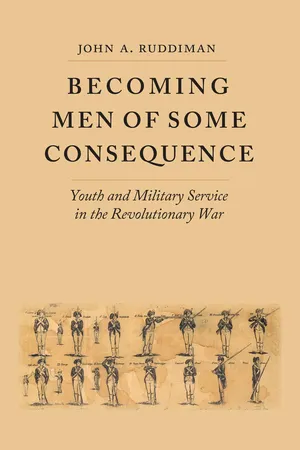History
The Continental Army
The Continental Army was the unified military force of the thirteen American colonies during the American Revolutionary War. Established in 1775, it was led by General George Washington and played a crucial role in securing American independence from British rule. The army faced numerous challenges, including lack of resources and training, but ultimately emerged victorious in the war.
Written by Perlego with AI-assistance
Related key terms
1 Key excerpts on "The Continental Army"
- eBook - ePub
Becoming Men of Some Consequence
Youth and Military Service in the Revolutionary War
- John A. Ruddiman(Author)
- 2014(Publication Date)
- University of Virginia Press(Publisher)
168 For poor youths without patrons or protectors, joining the army was not necessarily a free choice. The logic of the life course and youths’ ambitions proved persistent and difficult to overcome, however. Youths’ decision to go for soldiers unfolded within a constellation of their ambitions for advancing in life—to build up a stake through enlistment bounties and army wages, assert their status as gentlemen, or escape domestic control or the domination of servitude. The examples of earlier generations and the promises of their communities and Congress assured young men that taking up arms would advance them along the path toward manly independence. Their expectations were not unreasonable, but circumstances changed beyond their control or prediction. Even as drafts singled out young men for more-intense military service, youths found military engagements that balanced their domestic situation, the value of their time, the depreciation of currency, and the uneven risks of war. As a result, many gave The Continental Army a wide berth, imposing stark limits on the war effort.The young United States never assembled a Continental Army sufficient in itself to win its independence because Congress, states, and communities offered young men too many options for satisfying their military obligations and manly ambitions. Washington’s recruiting officers and the state governments could not fill the eighty-eight battalions Congress authorized for the campaign of 1777. As Richard Henry Lee of Virginia noted, “If the 88 Batallions were at once complete, adieu to British Tyranny and every chance for its succeeding.”169 That hoped-for Continental Army of 75,000 soldiers could have driven the king’s regulars from America’s shores, defeating Burgoyne at Saratoga, overwhelming Howe before Philadelphia, and then marching to besiege New York City. In 1777, however, The Continental Army reached its largest size with only 39,443 men—a total that was still 20 percent below the peak mobilization of 1776.170 With the terms Congress offered recruits, The Continental Army could not compete with the other opportunities for military service.Always undermanned, The Continental Army barely maintained effectiveness through these short-term replacements and militia support. As a consequence, The Continental Army lacked the strength to conclude the war on its own. Washington had to look for luck and French aid. The resulting delays and uncertainties after 1777 provoked financial collapse, almost broke the confederation, and nearly lost the struggle for independence. Blame does not lie with the young men of the Revolutionary generation, however. They met the obligations imposed by their communities, followed the military precedents and expectations of prior generations, and sought a path toward manhood through a landscape ravaged by war.
Learn about this page
Index pages curate the most relevant extracts from our library of academic textbooks. They’ve been created using an in-house natural language model (NLM), each adding context and meaning to key research topics.
